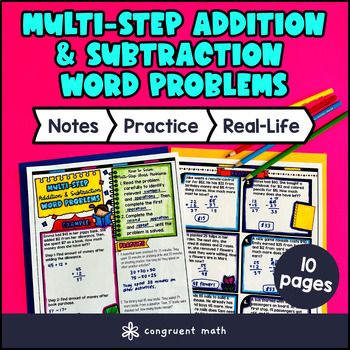Want more ideas and freebies?
Get my free resource library with digital & print activities—plus tips over email.
Join for Free Resources →
$4.25
Ever wondered how to teach multistep word problems involving addition and subtraction in an engaging way to your 4th grade students?
In this lesson plan, students will learn how to solve multi-step addition and subtraction word problems and explore their real-life applications. Through artistic, interactive guided notes, checks for understanding, a color-by-code activity, and a maze worksheet, students will gain a comprehensive understanding of multistep problem solving.
The lesson culminates with a real-life example that shows how these skills apply to everyday situations requiring careful calculation and reasoning.

$4.25
After this lesson, students will be able to:
Before this lesson, students should be familiar with:
As a hook, ask students if they have ever had to figure out the total cost of several items after shopping or how much money they would have left after spending part of it on different things. Invite them to share examples from their own experiences to connect with the idea of solving multistep addition and subtraction problems in real life. Refer to the last page of the guided notes as well as the FAQs below for additional ideas on sparking student interest.
Use the first page of the guided notes to introduce what multistep word problems are, emphasizing that these problems require more than one step—usually involving both addition and subtraction—to find the answer. Walk through key points such as how to identify the question being asked, underline important information and numbers, and decide whether to add or subtract at each step. Highlight the importance of solving the problem step-by-step instead of trying to do everything at once. Refer to the FAQ below for strategies on guiding students who struggle to identify relevant information.
Use the second page of the guided notes to model solving a sample multistep problem together with the class. Demonstrate how to break the problem into parts, write an equation or number sentence for each step, and check the work before arriving at a final answer. Emphasize the habits of rereading the problem and verifying answers make sense in context. Address common misconceptions such as mixing up when to add or subtract and missing steps by referring to the FAQ below for additional prompts and questioning techniques.
Based on student responses during these guided notes and class discussions, reteach concepts where needed, such as carefully identifying steps or choosing operations. For classrooms with a wide range of proficiency levels, consider pulling small groups for targeted reteaching while encouraging more advanced students to begin working independently on the practice exercises.
Have students practice multistep addition and subtraction word problems using the color by code and maze activities. Walk around to answer student questions.
Fast finishers can dive into the problem sets for extra practice. You can assign it as homework for the remainder of the class.
Bring the class back together, and introduce the concept of using multistep addition and subtraction word problems to solve real-life situations, such as budgeting money, planning events, or managing time. Emphasize how breaking down complex problems into smaller steps helps in making accurate decisions in everyday life. Refer to the FAQ for more ideas on how to teach it!
If you’re looking for digital practice for multistep addition and subtraction word problems, try my Pixel Art activities in Google Sheets. Every answer is automatically checked, and correct answers unlock parts of a mystery picture. It’s incredibly fun, and a powerful tool for differentiation.
Here’s 2 activities to explore:
Multistep word problems require solving more than one mathematical operation or step to find the solution. They often involve multiple addition and subtraction steps to solve real-life scenarios.
When teaching multistep word problems: **Break down the problem into smaller parts, identify the operations needed, solve each step carefully, and check your answer to ensure it makes sense in context.
Effective strategies include: **Read the entire problem carefully, underline key information, write down what is asked, plan the steps needed, solve step-by-step, and double-check your work.
They help students: **Develop critical thinking and problem-solving skills, apply math to real-life situations, improve reading comprehension, and meet core standards like 4.OA.A.3.
Guided notes help by: **Organizing key concepts clearly, providing scaffolded steps, engaging students through interactive elements like doodles or color codes, and allowing checks for understanding.
Common mistakes include: **Rushing without reading carefully, mixing up addition and subtraction, forgetting to complete all steps, and misinterpreting the question.
Coloring activities enhance engagement by: **Making learning fun and creative, helping students visually organize information, reducing math anxiety, and encouraging active participation.
The 4.OA.A.3 standard requires students to: **Solve multistep word problems involving addition and subtraction of whole numbers, and represent these problems using equations with a letter standing for the unknown quantity.
Yes, multistep word problems often use real-life scenarios to make math relevant and meaningful, helping students see how math applies outside the classroom in everyday situations.
Get my free resource library with digital & print activities—plus tips over email.
Join for Free Resources →